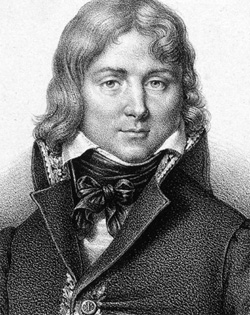General Jean Étienne Championnet

Born: April 14, 1762
Place of Birth: Valence, Drôme, France
Died: January 9, 1800
Cause of Death: Illness
Place of Death: Antibes, France
Arc de Triomphe: CHAMPIONNET on the north pillar
Pronunciation:
The son of Madeleine Vachier and an unidentified father, due to his lack of a known father Jean Étienne Championnet took to calling himself Championnet.1 His military career began in the royal army, and he took part in the siege of Gibraltar as part of the Spanish army in 1782. In July of 1789 he became a grenadier in the National Guard of Valence, and less than a year later he was a lieutenant. In September of 1792 Championnet was elected a lieutenant colonel of the 6th Battalion of Volunteers of Drôme. The following year he was tasked with stopping the insurgents of Jura and after accomplishing this he was promoted by the representatives of the people to chef de brigade in September. Not long thereafter he was sent to serve as part of the Army of the Moselle. In November Championnet fought at Kaiserslautern and then in December he served at Brumpt, Bischwiller, and Haguenau. Next he took command of a detached corps of the army and with this force he relieved Landau and occupied both Spire and Worms. In February of 1794 Championnet was promoted to général de brigade and the next month he was selected to replace Taponier in command of a division in the left wing under Hatry. After fighting at Arlon in April, he received a promotion to général de division in June, and that same month he fought at Chapelle d'Herlaymont and Fleurus .
Now commanding a division in the Army of the Sambre and Meuse, Championnet served at the fighting of Aldenhoven, and later took Juliers and Cologne. By May of 1795 he was serving under Kléber and in September he participated in taking Dusseldorf. 1796 saw Championnet serving at the passage of the Rhine at Neuwied, he was victorious at Camberg, he laid siege to the fort at Koenigstein, and he fought at Amberg and Wurzburg.
At the end of January of 1797, Championnet became interim commander of the Army of the Moselle for a week, and then Moreau extended his tenure to the 25th of February. After the 25th, Championnet assumed command of the right wing of the army, and in April he covered the crossing of the Rhine at Neuwied and won a victory at Steinberg. The next month he returned to a divisional command, taking charge of the 4th Division. That December he took command of the 3rd Division of the Army of Mainz, and in January of 1798 he was designated commander of the right wing of the Army of England. In May Championnet repulsed a tentative British disembarkment at Ostend. Championnet returned to the Army of Mainz to command a division of the advance guard in August.
In October of 1798 Championnet was named commander-in-chief of the Army of Rome, replacing Gouvion St. Cyr, but he did not take up this command until November. Before long he was forced to evacuate Rome with his army. However, wasting no time, Championnet won the battle of Civita Castellana and re-entered Rome in January, then went on to take Capua and Naples. Named commander-in-chief of the Army of Naples, he quit his command in February, and then was arrested in Milan in March. Charges were brought against him including disobeying the orders of the government and seizing the public funds of Naples, but these were possibly political moves against him by his enemies, including General Macdonald. By July a military tribunal had acquitted him of all charges and he was named commander-in-chief of the Army of the Alps, under Joubert's overall command of the campaign.
After Joubert's death at Novi , Championnet was named commander of the Army of Italy, and then in September he took command of the left wing of this army. With this force he took Suze, and after arriving at Genoa he took command of the army from Moreau. That November he was beaten at Genola, and in December he fell gravely ill, quitting his command on the 30th. As the epidemic raged through his army, his condition deteriorated and he died on the 9th of January. At his death, he was so poor that there were no funds for his funeral, and his staff had to pool funds to give him a modest funeral.2
Notes
- John R. Elting, Swords Around a Throne: Napoleon's Grande Armée, (USA: Da Capo Press, 1997), 158.
- Ibid., 158.
Bibliography
- Divry, Arnauld. Les Noms Gravés sur l'Arc de Triomphe. Paris: L'Harmattan, 2017.
- Six, Georges. Dictionnaire Biographique des Généraux & Amiraux Français de la Révolution et de l'Empire (1792-1814). 2 vols. Paris: Gaston Saffroy, 2003.
Updated April 2025
© Nathan D. Jensen